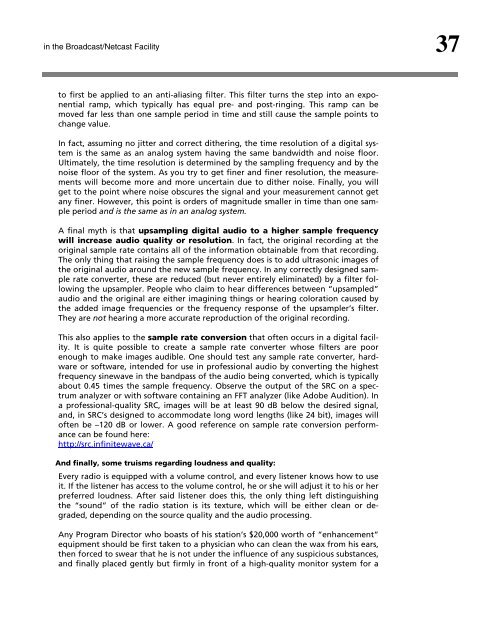Maintaining Audio Quality in the Broadcast Facility 2011 - Orban
Maintaining Audio Quality in the Broadcast Facility 2011 - Orban
Maintaining Audio Quality in the Broadcast Facility 2011 - Orban
Create successful ePaper yourself
Turn your PDF publications into a flip-book with our unique Google optimized e-Paper software.
<strong>in</strong> <strong>the</strong> <strong>Broadcast</strong>/Netcast <strong>Facility</strong> 37<br />
to first be applied to an anti-alias<strong>in</strong>g filter. This filter turns <strong>the</strong> step <strong>in</strong>to an exponential<br />
ramp, which typically has equal pre- and post-r<strong>in</strong>g<strong>in</strong>g. This ramp can be<br />
moved far less than one sample period <strong>in</strong> time and still cause <strong>the</strong> sample po<strong>in</strong>ts to<br />
change value.<br />
In fact, assum<strong>in</strong>g no jitter and correct di<strong>the</strong>r<strong>in</strong>g, <strong>the</strong> time resolution of a digital system<br />
is <strong>the</strong> same as an analog system hav<strong>in</strong>g <strong>the</strong> same bandwidth and noise floor.<br />
Ultimately, <strong>the</strong> time resolution is determ<strong>in</strong>ed by <strong>the</strong> sampl<strong>in</strong>g frequency and by <strong>the</strong><br />
noise floor of <strong>the</strong> system. As you try to get f<strong>in</strong>er and f<strong>in</strong>er resolution, <strong>the</strong> measurements<br />
will become more and more uncerta<strong>in</strong> due to di<strong>the</strong>r noise. F<strong>in</strong>ally, you will<br />
get to <strong>the</strong> po<strong>in</strong>t where noise obscures <strong>the</strong> signal and your measurement cannot get<br />
any f<strong>in</strong>er. However, this po<strong>in</strong>t is orders of magnitude smaller <strong>in</strong> time than one sample<br />
period and is <strong>the</strong> same as <strong>in</strong> an analog system.<br />
A f<strong>in</strong>al myth is that upsampl<strong>in</strong>g digital audio to a higher sample frequency<br />
will <strong>in</strong>crease audio quality or resolution. In fact, <strong>the</strong> orig<strong>in</strong>al record<strong>in</strong>g at <strong>the</strong><br />
orig<strong>in</strong>al sample rate conta<strong>in</strong>s all of <strong>the</strong> <strong>in</strong>formation obta<strong>in</strong>able from that record<strong>in</strong>g.<br />
The only th<strong>in</strong>g that rais<strong>in</strong>g <strong>the</strong> sample frequency does is to add ultrasonic images of<br />
<strong>the</strong> orig<strong>in</strong>al audio around <strong>the</strong> new sample frequency. In any correctly designed sample<br />
rate converter, <strong>the</strong>se are reduced (but never entirely elim<strong>in</strong>ated) by a filter follow<strong>in</strong>g<br />
<strong>the</strong> upsampler. People who claim to hear differences between “upsampled”<br />
audio and <strong>the</strong> orig<strong>in</strong>al are ei<strong>the</strong>r imag<strong>in</strong><strong>in</strong>g th<strong>in</strong>gs or hear<strong>in</strong>g coloration caused by<br />
<strong>the</strong> added image frequencies or <strong>the</strong> frequency response of <strong>the</strong> upsampler’s filter.<br />
They are not hear<strong>in</strong>g a more accurate reproduction of <strong>the</strong> orig<strong>in</strong>al record<strong>in</strong>g.<br />
This also applies to <strong>the</strong> sample rate conversion that often occurs <strong>in</strong> a digital facility.<br />
It is quite possible to create a sample rate converter whose filters are poor<br />
enough to make images audible. One should test any sample rate converter, hardware<br />
or software, <strong>in</strong>tended for use <strong>in</strong> professional audio by convert<strong>in</strong>g <strong>the</strong> highest<br />
frequency s<strong>in</strong>ewave <strong>in</strong> <strong>the</strong> bandpass of <strong>the</strong> audio be<strong>in</strong>g converted, which is typically<br />
about 0.45 times <strong>the</strong> sample frequency. Observe <strong>the</strong> output of <strong>the</strong> SRC on a spectrum<br />
analyzer or with software conta<strong>in</strong><strong>in</strong>g an FFT analyzer (like Adobe Audition). In<br />
a professional-quality SRC, images will be at least 90 dB below <strong>the</strong> desired signal,<br />
and, <strong>in</strong> SRC’s designed to accommodate long word lengths (like 24 bit), images will<br />
often be –120 dB or lower. A good reference on sample rate conversion performance<br />
can be found here:<br />
http://src.<strong>in</strong>f<strong>in</strong>itewave.ca/<br />
And f<strong>in</strong>ally, some truisms regard<strong>in</strong>g loudness and quality:<br />
Every radio is equipped with a volume control, and every listener knows how to use<br />
it. If <strong>the</strong> listener has access to <strong>the</strong> volume control, he or she will adjust it to his or her<br />
preferred loudness. After said listener does this, <strong>the</strong> only th<strong>in</strong>g left dist<strong>in</strong>guish<strong>in</strong>g<br />
<strong>the</strong> “sound” of <strong>the</strong> radio station is its texture, which will be ei<strong>the</strong>r clean or degraded,<br />
depend<strong>in</strong>g on <strong>the</strong> source quality and <strong>the</strong> audio process<strong>in</strong>g.<br />
Any Program Director who boasts of his station’s $20,000 worth of “enhancement”<br />
equipment should be first taken to a physician who can clean <strong>the</strong> wax from his ears,<br />
<strong>the</strong>n forced to swear that he is not under <strong>the</strong> <strong>in</strong>fluence of any suspicious substances,<br />
and f<strong>in</strong>ally placed gently but firmly <strong>in</strong> front of a high-quality monitor system for a



![[PDF] Using the ITU BS.1770-2 and CBS Loudness Meters ... - Orban](https://img.yumpu.com/50629372/1/190x245/pdf-using-the-itu-bs1770-2-and-cbs-loudness-meters-orban.jpg?quality=85)






![[PDF] Optimod-FM Feature Comparison - Orban](https://img.yumpu.com/41741615/1/190x245/pdf-optimod-fm-feature-comparison-orban.jpg?quality=85)






